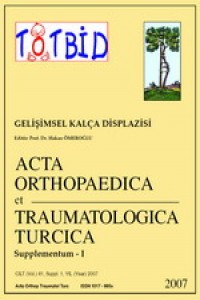Öz
Gelişimsel kalça displazisinin tedavisinde karşılaşılan en önemli sorunlardan biri kalıcı kalça displazisidir. Bu durum, tedavi edilmediğinde erişkinlik döneminde sorunlara yol açabilir. Gelişen asetabulum, ilium, iskium ve pubis ile bunlar arasındaki üçlü kıkırdaktan oluşur. Üçlü kıkırdağın büyüme plaklarından olan interstisyel büyümenin asetabulumun gelişmesi üzerinde önemli etkisi vardır. Bu gelişme sırasında anatomik eklem ilişkisinin ve devamlılığının sürmesi gerekir. İlk sekiz yaşta çok hızlı olmakla birlikte, asetabulum gelişiminin erişkinlik dönemine kadar sürdüğü kabul edilir. Gelişimsel kalça displazisinin tedavisinde kalıcı displazi gelişip gelişmeyeceği, takip döneminde bu gelişime etkili unsurlar göz önünde tutularak değerlendirilir. Hastanın yaşı, asetabulum ile baş uyumu, başın yuvarlaklığı, başın orta çizgiye olan uzaklığı ve asetabuler çatı kalınlığı asetabulumun gelişmesinde değerlendirilmesi gereken en önemli unsurlardır. Olguların bu unsurların ışığında izlenmeleri, gereksiz cerrahi girişimlerin önlenmesi ve başarılı sonuçların alınması için önemlidir.
Anahtar Kelimeler
Öz
Residual hip dysplasia is one of the most important complications following treatment of developmental hip dysplasia. If untreated, this condition will cause problems during maturity. The acetabulum consists of the ilium, ischium, pubis, and the triradiate cartilage lying between them. Interstitial growth from the growth plates of the triradiate cartilage plays an important role in the development of the acetabulum. Concentricity and congruity should be maintained during this development, which is very fast during the first eight years and continues until maturity. Whether residual hip dysplasia will occur can be anticipated by evaluating the factors that are effective on this development during the treatment of developmental hip dysplasia. The main prognostic factors include the age of the patient, concentricity and congruity of the hip, sphericity of the femoral head, the distance from the center to the head, and the thickness of the acetabular roof. Taking these factors into consideration during the follow-up is important to eliminate overtreatment and to assess the success of treatment.
Anahtar Kelimeler
Ayrıntılar
| Birincil Dil | İngilizce |
|---|---|
| Konular | Sağlık Kurumları Yönetimi |
| Bölüm | Derleme |
| Yazarlar | |
| Yayımlanma Tarihi | 18 Nisan 2007 |
| Yayımlandığı Sayı | Yıl 2007 Cilt: 41 |

